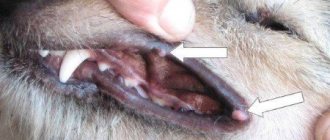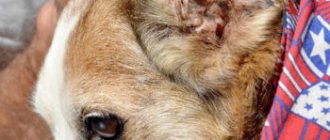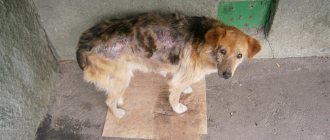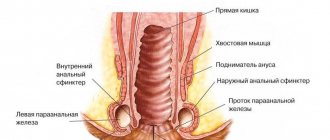Why does otitis media develop in dogs?
There are a number of main reasons for the development of otitis media in dogs.
Regular ear cleaning is the best prevention for otitis media.
- Decreased immunity. Low activity of the pet's immune system leads to a weakening of the protective function of the skin. As a result, numerous microorganisms and fungus multiply in the ears, and inflammation develops.
- Presence of fur in the ears. Too thick hair in a dog's ears has several negative effects: it interferes with the removal of excess wax from the ear canal, blocks the access of air (stagnation and waterlogging occurs), irritates the skin, leading to increased work of the ear glands.
- Neoplasms in the ear. Growths in the ear canal can interfere with ventilation, bleed, fester, causing an active increase in the number of pathogenic microbes.
- Allergy. Allergic reactions cause otitis media by increasing the secretion of sulfur and reducing local immunity.
- Ear mite. Damages the skin of the ear canal, causing inflammation.
- Proliferation of cartilage and skin folds. This feature is typical for dogs of certain breeds, for example, Shar-Pei. As a result of an excessive increase in the size of the folds in the ear canal, gas exchange in it is disrupted.
- Water penetration. Stagnation of fluid in the ear promotes the proliferation of pathogenic microorganisms.
- Entry of a foreign body. If a foreign object gets stuck in a dog’s ear, the air supply will stop, irritation of the nerve endings will begin, excessive amounts of wax will be released, and bacteria will grow.
- Hormonal disbalance. Any endocrine disorders can cause excessive secretion of sulfur, reducing local defenses.
- Poor nutrition. Excessive amounts of simple sugars (sweets) in your pet's diet result in their presence in the sulfur produced. Released in increased volume, it becomes a breeding ground for infection.
- Heredity. Animals with floppy ears (spaniels), excessively open shells (shepherd dogs) and prone to allergies are more likely to develop otitis than others.
Diagnostics and therapy
As a rule, making a diagnosis of otitis is quite easy, since the clinical signs of the disease are very characteristic. The owner of the animal needs to inform the specialist when and after what the dog showed signs of illness. In addition, the veterinarian will take blood and urine tests from the dog, as it is important to determine the overall health of the animal. It should be noted here that some autoimmune diseases, allergies, hormonal imbalances, etc., can give a similar clinical picture, so their presence must be excluded during diagnosis.
In addition, which is especially important in the case of the fungal nature of the disease, you need to find out which particular fungus caused the inflammation of the ears. To do this, a scraping of pathological material is taken from the affected ear, after which it is subjected to microscopic examination. It is even better when it is possible to sow on a nutrient medium, since from the grown culture of the pathogen it is easier to accurately determine the type of pathogenic microorganism. There is only one problem - mushrooms grow extremely reluctantly and slowly “in the garden beds”, which is why the appointment of adequate treatment may be delayed, and in this case this is very undesirable.
What is the treatment for fungal otitis media in dogs? One is the prescription of powerful antifungal drugs , and drops are most often used, which are conveniently instilled into the ear canals of a sick animal. It is important to make sure that there are no deposits in the ears - before using medications, “garbage” must be removed, stocked with cotton swabs and sterile vegetable oil. In addition, you can use a warm, sterile saline solution to soften deposits in the lumen of the ear canal. Please note that this will have to be done before each administration of the medicinal composition, since otherwise the medicine may not reach its “destination”.
As for specific drugs, the following drugs have proven themselves well: Tresaderm, Oritsin, Oridermil, Nitrofungin, Clotrimazole. It is important to note that they are used only for “pure” fungal mycoses. If the disease is complicated by ticks or pathogenic microbes, combined treatment is needed. Be that as it may, only a veterinarian should prescribe it.
Important! Do not try to treat fungal ear infections on your own, as you will only prolong the process and it can all end very badly for your pet.
Photo of otitis media in dogs
How does otitis media manifest in dogs?
Symptoms of otitis in a dog can be varied, the degree and form of their severity depends on the type of disease, immunity, individual characteristics of the pet, and the neglect of the process. The owner should contact the clinic if he notices the following symptoms:
- the animal shakes its head or scratches its ears frequently;
- the pet does not allow you to touch its ears;
- discharge appeared from the external auditory canal;
- the dog whines when he tries to scratch his ears;
- too much sulfur in the passage;
- at the beginning of the ear canal, hair falls out, ulcers, redness, and wounds appear;
- the lymph nodes under the animal’s jaw are enlarged;
- the ears are hot to the touch, and swelling is observed.
As the pathological process develops, the pet’s overall body temperature rises and he refuses to eat.
In some cases, the predominance of one or another symptom may indicate the cause of otitis media.
Cause
Symptom
Wool
Hair growing deep
Ear mite
There are dark-colored crusts on the surface of the skin of the auricle and ear canal. When they are removed, wounds can be distinguished
Bacteria, fungi
Skin swelling, redness, suppuration, increased local and general temperature
Water
Liquid discharge from the ears
Allergy
The appearance of an allergic reaction in other parts of the body
Clinical and laboratory diagnosis of otitis in dogs and cats (Abstract)
Masimov Eduard Nusratovich Veterinarian, dermatologist, endocrinologist, therapist Candidate of Biological Sciences
Otitis media - a problem, a disease, a symptom?
During his practice, a veterinarian encounters this pathology quite often in both dogs and cats. According to statistics, in the Lebedi network of veterinary clinics, out of 100% of dermatological patients, more than 50% have otitis media as a concomitant pathology or the main problem.
To successfully help a patient with this pathology, the veterinarian must first of all clearly know the anatomy of the animal’s ear canal .
The animal's ear itself is divided into the external auditory canal, middle and inner ear, and all this is preceded by the auricle. It is also worth remembering the presence of apocrine glands in the skin.
The auricle has an internal concave surface and an external convex surface. Has the shape of a funnel. The auricle serves to receive air vibrations and transmit them through the ear canal to the eardrum. The shape of the ear itself depends on the breed of dog or cat.
External auditory canal (EA) - occupies the space between the eardrum and the auricle. The diameter of the ear canal normally ranges from 5 to 10 mm - this is determined by the breed and age of the animal. And the length of the ear canal is on average about 2 cm. The NSP is lined with auricular and annular cartilages. And they, in turn, are lined with skin.
The ESP and the middle ear are separated by the eardrum. Its thickness is no more than 0.2 mm and appears translucent. The membrane consists of three layers: the skin covering it from the outside, the connective tissue base and the mucous membrane.
The middle ear, which starts from the eardrum, is divided into 3 parts: 1. a large, ventral tympanic bulla in the temporal bone, 2. a small, deep tympanic recess, which is located above the eardrum itself 3. and the tympanic cavity.
The inner ear contains the sense organs for hearing and balance. It is located inside the temporal bone.
Diagnostics . Diagnosis of otitis is important. Neglecting diagnosis can lead to failures in treatment, negative reviews of your work as a doctor, and, of course, to a deterioration in the four-legged patient’s health.
It is important to collect a complete medical history. What the veterinarian hears from the owner is what he will rely on! Therefore, it is important to ask the owner of a sick animal true and relevant questions. The doctor should pay attention to the conditions in which the animal is kept, its walking schedule, and the frequency of bathing. The owner's survey must include a question about the duration of otitis media and the presence of seasonality of the disease. How does the owner take care of the dog’s ears, do they use ear sticks or ear drops? If otitis media has not occurred for the first time, what was the treatment before contacting you? What results did it give? All these questions will lead the veterinarian to the right track, and will also indicate the possible causes of the pathology.
There are many reasons that can cause otitis media. They are divided into predisposing, primary, secondary and supporting. Predisposing factors will be floppy ears (basset hounds, labradors, spaniels), frequent swimming or bathing, the presence of thick fur near the ear canal, excessive or, conversely, insufficient care for the ears of the pet owner.
Primary causes. These are ectoparasites, foreign bodies, hypersensitivity, autoimmune diseases, keratinization disorders.
Secondary causes usually aggravate otitis media. These are bacteria (cocci), fungi (Malassezia).
But supporting causes are an obstacle to the treatment of otitis media. These include otitis media, skin edema, epithelial folds, and glandular hyperplasia.
Visual examination of the animal:
- Position of the head in space (the head may be tilted - this indicates pain, as well as possible neurological problems resulting from otitis media)
- Careful palpation of the ear (how pronounced is the itching, pain)
- Is there any discharge or pus in the NSP?
- Odor from the ear
- Presence of NSP hyperplasia
- Checking your dog's hearing
- Review of the skin immediately adjacent to the affected ear
- Palpation of the lymph nodes (often an enlarged lymph node can “give away” the diseased ear. There are quite a few such lymph nodes near the ear canal: parotid, mandibular, medial retropharyngeal. All of them, or individually, can enlarge with otitis of the external auditory canal, or with inflammation of the cochlea.)
Each of the two ears should be examined, even if the owner indicates a specific ear of the pet. In such a situation, you can safely compare the “healthy” and “sick” ears, essentially “normal” and “not normal.”
Taking samples for cytology . Cytological examination of exudate is a simple and quick method that can provide the necessary information about the bacterial, fungal and parasitic composition of the contents of the NSP. The smears are pre-sealed (for example, using a regular lighter), after which they are stained with Gram or Diffquick and examined using a microscope. The presence of coccal forms of bacteria in smears indicates the presence of staphylococci or streptococci. Detection of rod-shaped bacteria indicates the presence of Proteus or pseudomonads. Yeasts are almost always represented by various species of the genus Malassezia, however, representatives of the genus Candida can also be found.
It is also important to correctly interpret the findings and compare them with the clinical picture. For some dog breeds (basset hound), the presence of Malassezia may be normal. With any number of bacteria, as well as with the presence of phagocytosis, an infectious process occurs. Rods and pseudomonas are pathogens.
It is also necessary to take note of cultural studies. They are necessary to determine the sensitivity of microorganisms to antibiotics, especially when Gram-negative rods are detected in smears, which may belong to the genus Pseudomonas. In this case, growing a culture and testing for sensitivity to antibiotics are mandatory, since microorganisms belonging to this genus are often resistant to most antibacterial agents. The research itself is rare.
Otoscopy . An important instrumental method in the diagnosis of otitis media. For a thorough examination of the ear canals, veterinary otoscopes with a halogen light source and attachments of various thicknesses and lengths are used. It is believed that the attachments used to examine the ears of humans are in most cases unsuitable for use in dogs, since they do not allow them to penetrate deep enough and examine the horizontal part of the passage and the eardrum. Sometimes otoscopy may not be possible on the first visit to the veterinarian (the animal is aggressive, in pain and discomfort).
Diagnostics can also include methods such as video otoscopy, X-ray examination, and MRI. They are carried out, if necessary, both separately and comprehensively.
Video otoscopy. A modern method of not only diagnosis, but also treatment. May relate to morphological research. The diagnostic value can be increased due to the possibility of using a biopsy followed by morphological examination. With the help of endoscopy, the veterinarian will be able to thoroughly rinse the ear canal. With this procedure, it is possible to perform a myringotomy and lavage of the middle ear.
X-ray examination . It is a good research method, but this method is not as sensitive as MRI. Radiography should be performed in several projections: dorsoventral, ventrodorsal and lateral. Sedation is usually necessary.
MRI. More sensitive to the study of soft tissues and structures than CT. As a rule, this method is used in the presence of otitis media, in case of emerging neuralgic pathologies in dogs or cats.
As studies by European colleagues – veterinarians – show, dermatological problems often push the owner to change clinics and doctors. This is due to the specifics of dermatology, in which intuition often fails. Therefore, paying attention to seemingly standard problems is simply necessary.
A complete examination of a patient with a dermatological problem is an important task that a veterinarian must solve.
Return to list
Types of otitis media in dogs
There are several classifications of otitis media in dogs.
By origin
- Primary. Develops independently (hypothermia).
- Secondary. It is a consequence of any disorders, for example, hormonal ones.
By localization
- Otitis externa.
- Otitis media.
- Internal otitis. The most dangerous, since the eardrum and cartilage tissue become inflamed. There is a threat of sepsis and spread of the process to the brain.
By the nature of the discharge
- Purulent.
- Exudative (a lot of sulfur is released).
With the flow
- Spicy. It is characterized by severe pain and a sharp development of symptoms.
- Chronic otitis media. Has vague symptoms. It is characterized by a long course with alternating periods of exacerbation and remission.
According to the source of inflammation
- Fungal. The fungus multiplies very intensively, so the disease quickly spreads to the inner ear. The symptoms are pronounced, which brings anxiety and pain to the pet.
- Bacterial. Accompanied by an increase in temperature and the formation of crusts on the surface of the ear canal.
- Malassezia otitis media. Refers to fungal types of otitis. The causative agent is Malassezia. It is present on the surface of the skin of the dog’s ear, but manifests itself only when the body’s defenses are reduced. Often accompanied by a bacterial infection.
- Allergic. Manifests itself in swelling, itching, redness of tissues. Does not respond to antifungal and antibacterial drugs. An allergy can be suspected if similar symptoms are found in other parts of the body.
- Verrucous otitis media (warty). Numerous warts and growths form on the surface of the dog’s ear skin, which gradually block the ear canal, leading to inflammation.
Important: to diagnose the type of otitis in a dog, it is better to consult a specialist. Only laboratory tests can accurately indicate the cause of the disease. Self-selection of medications can cause complications, including deafness or inflammation of the meninges and the death of the pet.
How to diagnose
Examination by a veterinarian
At the veterinary clinic, the owner will need to not only show the dog to a specialist, but also answer a number of questions. Of great importance for making a diagnosis are: diet (predominant product or feed), walking habits, presence or absence of vaccinations, chronic diseases. You will need to remember when the symptoms appeared, what the nature of the disease is, the behavior of the animal and other nuances.
For diagnosis, a veterinarian may prescribe the following types of examinations:
- blood tests, discharge from the ear canal;
- scraping from the ear;
- x-ray (if a foreign object is suspected);
- tomography (to assess the condition of the inner ear, meninges).
Breed predisposition
All dogs, regardless of breed, can suffer from this disease. Fungal otitis occurs due to infections, decreased immunity, improper or insufficient ear care.
But despite this, experts identify a risk zone in which East European Shepherds . Their ear canal is too wide, into which dirt can easily get in; it can quickly become hypothermic while walking in the winter. This can cause an inflammatory process and the spread of fungus.
Treatment of otitis media in dogs
Treatment of otitis media in dogs is complex. The conservative approach includes a number of areas:
- eliminating the cause (if possible);
- relieving swelling, itching, pain;
- getting rid of crusts, discharge, external treatment;
- detoxification of the pet's body;
- destruction of pathogenic microbes in the ear and throughout the body;
- strengthening the immune system.
If we are talking about overgrowing of the ear canal, tumors, or a foreign body, then surgical intervention is possible.
Due to the variety of forms of ear inflammation in dogs, treatment will vary. Thus, for chronic otitis, in addition to antibacterial drugs prescribed during an exacerbation, it is recommended to use drops to prevent the growth of fungi and bacteria. Fungal otitis requires the use of antimycotic agents, and bacterial inflammation is treated with antibiotics. When diagnosing allergic otitis, first of all, a strict diet and antihistamines are prescribed.
What is otitis media, its types
The dog's ears are bothering him, he scratches them and constantly shakes them - this is an ear infection in a dog, treatment must be prescribed immediately. But there are a great many otitis media and treatment options, too. The disease will be cured much faster and the result will be much higher if the exact nature of otitis media, its cause, or what exactly caused it is established. Thus, otitis differs from each other as caused by microorganisms, an allergic reaction of the body, neoplasm, injury, foreign body, as well as the course and localization of the process itself. With high quality treatment, the likelihood of disease recurrence is much less.
Purulent
In most cases, purulent otitis is of a bacterial nature with all its diversity. The very concept of “purulent” speaks of its generalized form and the presence of pus itself. It is important to note that a foreign body remaining in the ear for a long time will also lead to such otitis media, but not on its own, but as an alternative factor that creates conditions for bacteria. It is characterized by the presence of a large amount of white-yellow discharge with a characteristic unpleasant odor. It is one of the most severe forms of otitis because the risk of rotting of the eardrum is very high.
If pus gets outside of it, it has catastrophic consequences for the pet. With purulent otitis media, a dog's ears often leak, how to treat it? It is very important to identify the causative agent of the process and determine its sensitivity to antibiotics. Bacterial sowing will help. If there is no access to research, broad-spectrum antibiotics are used (for example, Bicillin 3).
Allergic
Allergic otitis is a specific reaction of the body to some substance that causes just this form of otitis. When the allergen is eliminated from the body, the disease also goes away. But if a secondary infection develops, treatment may take longer. This reaction in dogs does not follow a stable trend. It arises exclusively through the individual characteristics of the dog.
But it is worth noting that dogs with floppy ears are more susceptible to allergic otitis media. You can try to eliminate the allergen experimentally, that is, by eliminating new foods, new things and everything that was not there before the reaction, but this is troublesome. The laboratory will give the exact answer.
Fungal (yeast)
The very name “fungal” and “yeast” speaks about the nature of the disease. The yeast itself is found on the fur and skin of any dog and does not cause harm. Yeast otitis media develops when immunity declines. Moreover, it is otitis media that develops very individually. It all depends on the characteristics of the dog’s body.
When yeast actively multiplies, brown to red lesions begin to develop. And it is characteristic that these areas are much lighter than healthy areas (yeast secretes an oxidizing enzyme). Such otitis rarely causes itching, dandruff and other unpleasant phenomena. The matter is complicated by the layering of secondary infection with a subsequent decline in immunity. In the auricle itself and in its area (in severe cases), hair falls out. For treatment, Spectazol, Mentax and others are used plus symptomatic therapy.
Squelching and inflammation are characteristic signs of otitis in dogs caused by a fungus. In most cases, mushrooms of the Malassezia genus are found. Mushrooms love humidity and warmth. Such conditions can be present in abundance in the ears of our pets if a lot of sulfur, dirt, sticky hair has accumulated there, and at the same time a weakened immune system has occurred. Mushrooms will immediately begin to develop, and those mushrooms that were previously on the body and could not cause harm. If dirt is not removed from the ears and without proper ventilation of the auricle and its passages, the treatment will be ineffective. The therapeutic effect may not appear at all. Fungal otitis in a dog, how to treat it? Various antifungal drugs based on fluconazole, ketoconazole and others are used:
- Oritsin,
- Clotrimazole,
- Nitrofungin.
And therapy is required to relieve inflammation and possible layered infection.
Kleshchevoy
This name suggests that otitis media is caused by mites. So most often with this kind of otitis there are mites of the genus Otodectes (ear scabies), Sarcoptes (itching itch), Demodex (iron mites). If the first two always cause harm to the dog when they get on its body, then demodicosis manifests itself when the animal’s immunity drops. Demodexes themselves reside on the body of both animals and humans without causing harm. In immunosuppressive conditions, they manifest themselves throughout the body, including in the ears. They are localized in the sebaceous glands, hair follicles, etc.
A characteristic feature of tick-borne otitis is the relative dryness of the diseased ear (before the development of a secondary infection) and the presence of characteristic black discharge. To treat mites in the ears, drops for otitis media for dogs with insecticidal and acaricidal properties are used.
Verrucous (warty)
Verrucous otitis is a problem that occurs in the auricle by the formation of warts and overgrowth of the dog's ear canal. Such warts appear from chronically inflamed skin of the ear. The longer the process, the worse the spread of such warts throughout the ear canal.
But it happens that the cause is various neoplasms - papillomas, oncology, etc. Verrucous otitis of this nature is much more difficult to treat. Treatment comes down primarily to eliminating the root cause of the inflammatory process in the auricle. So the resulting warts at least begin to decrease in size, and may even disappear. After the causes of inflammation are removed, the remaining warts have to be operated on. If they do not interfere, then sometimes they can do without surgery. For other neoplasms that cause similar otitis media, a histological examination should be performed.
Complications of otitis media in dogs
Failure to consult a veterinarian in a timely manner or the sudden and rapid development of an infection can lead to dangerous complications, which is especially typical for bacterial otitis. In addition to the disease becoming chronic, the dog may have the following consequences:
- hearing impairment, deafness;
- inflammation of the membranes of the brain;
- neurological disorders;
- psychical deviations;
- swelling of the inner ear;
- purulent eye lesions, strabismus.
Features of treatment at home
Even if the owner knows how to treat a particular type of otitis in a dog, ear therapy at home should only be done after the pathogen has been identified. You should not immediately stuff your pet with antibiotics or instill the first drops that come to hand. Such “treatment” can lead to a deterioration in the animal’s condition.
Treatment of otitis media in dogs at home
What other rules must be followed when treating an animal at home? First, cleaning your ears should be done using a swab, not a stick. Due to its small size, it is impossible to fully hygiene the auricle and ear canal.
The owner must have the skills to clean the animal's ears, especially if the breed has a tortuous ear canal, there are numerous folds and cartilaginous growths. There is a high probability of causing pain in the dog through inept actions. In addition, if there are growths and folds, it will not be possible to properly see the surface of the skin and carry out hygiene.
Some owners believe that hydrogen peroxide should be instilled into the animal’s ear so that it “dissolves” deposits, which can then be easily removed. In fact, the solution is intended only for treating the sink. Penetrating into the ear and contacting pus, damaged surfaces, and wax, peroxide foams, leading to specific sounds in the ears. The animal may get scared.
All that is required from the owner is to provide the dog with peace, adequate competent treatment, adequate nutrition and attention.
Treatment
Treatment consists of eliminating the underlying disease (most often allergies or parasites), as well as using antifungal agents. For mild otomycosis, topical application of antifungal drops is sufficient. Before instillation, you need to make sure that a large amount of secretion has not accumulated in the ear canal. When treating otitis of any etiology, it is necessary to rinse the ear canal before using local agents. To do this, use warm solutions, either physiological or chlorhexidine solution 0.05% (if there is no perforation of the eardrum or suspicion of this problem) or special lotions (their use is also prescribed only by a doctor if the eardrum is not damaged). Washing is done several times a week. If there is too much discharge and it accumulates quickly, then the ear canal must be rinsed before each treatment. To do this, a warm solution is injected into the ear canal until it begins to pour out. Then they massage the base of the ear and let the dog shake its head so that the solution with the remaining secretions comes out. The outside is wiped with a gauze cloth (not cotton wool!!).
In moderate and severe forms of otomycosis, as well as in the presence of infection (according to cytology results), local treatment is not enough, and systemic antifungal agents are used.
What can you do before visiting the veterinarian?
If you cannot immediately seek help from a veterinarian, you can take several independent measures that will alleviate the dog’s condition.
- Inspect the concha and external auditory canal. This must be done carefully so as not to cause pain to the animal.
- If there are damages, treat them with a swab dipped in hydrogen peroxide.
- Otinum can be instilled into the ear. This product is not dangerous to the dog's health. It will help eliminate pain, itching, and soften deposits. It is better not to use other drops or ear ointment before a doctor’s examination and diagnosis, so as not to accidentally contribute to the resistance of microorganisms to further treatment.
- If your pet is febrile, you can give him an antipyretic drug, such as paracetamol.
May your dog's ears be healthy!
Prevention of otitis in dogs
Minor restrictions and rules for caring for your dog will help prevent the development of otitis media.
- The better the immune system, the less susceptible the dog is to infections and parasites. A nutritious diet and walks will help strengthen the body's defenses.
- Regular cleaning of the ear shells 1-2 times every 7-10 days is indicated not only as a hygienic procedure, but also as a preventive procedure (detection of the disease at an early stage).
- Hypothermia of the animal should be avoided.
- After water procedures (at home or in a pond), excess water should be removed by blotting the ear with a swab and tilting the dog’s head to the side.
- It is not advisable to let your pet go outside alone. The animal may be injured and may also “meet” other dogs infected with ear mites, fungal or other infections.
Attentive attitude towards your four-legged friend and, in case of otitis, a timely visit to the veterinary clinic will be the key to the health of the dog’s ears and the entire body.











